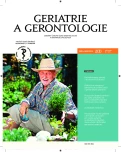A pharmacotherapy of nursing home residents.
Authors:
Mgr. Stanislava Kalafutová 1; Mgr. Hana Šulcová 2; MUDr. Božena Jurašková; Ph. D 3; prof. RNDr. Jiří Vlček, CSc. 4
Authors‘ workplace:
Katedra sociální a klinické farmacie FaF UK Hradec Králové
1; Nemocniční lékárna FN Motol, Praha
2; III. interní gerontometabolická klinika LF UKa FN Hradec Králové
3; Katedra sociální a klinické farmacie FaF UKHradec Králové
4
Published in:
Geriatrie a Gerontologie 2014, 3, č. 2: 65-70
Category:
Original Article/Study
Overview
Polypharmacy and the use of inappropriate medications in the elderly are a common cause of adverse drug reactions. Residents of nursing homes are more sensitive to poly-drug use and potential adverse drug reactions than community-dwelling seniors. The aim of this cross-sectional study was analysis of the pharmacotherapy in the nursing homes residents, focusing on the analysis of potentially in-appropriate medications in the elderly (using STOPP criteria) and drug interactions (using databases AISLP and software Micromedex). Medical information and demographic data were collected since February to May 2012. Statistical software MS Excel 2007 was used for statistical analyses.
The analysis was conducted in two nursing homes in Prague and Central region of the Czech Republic. Fifty eight residents aged 65 years and older were participated in the study. The mean age was 82 years, 74 % were female. Respondents were taking 8.9 prescription drugs, 1.2 non-prescription drugs and 0.6 dietary supplements per a capita. Potential drug interactions occurred in 86 % of respondents. Serious and very serious interactions occurred in 8.6% of respondents. 65 % of respondents were prescribed potentially inappropriate medicines.
The incidence of drug interactions among the nursing home residents is very high as well as the prescription of potentially inappropriate medicines.
Keywords:
nursing homes – pharmacotherapy of seniors – inappropriate medications in the elderly – drug interactions
Sources
1. Kalvach Z, Zadák Z, Jirák R a kol. Geriatrické syndromy a geriatrický pacient. Praha: Grada Publishing 2008.
2. Best O, Gnjidic D, Hilmer SN, et al. Investigating polypharmacy and drug burden index in hospitalised older people. Intern Med J 2013; 43(8): 912–918.
3. Fulton MM, Allen ER. Polypharmacy in the elderly: A literature Review.J Am Acad Nurse Pract 2005; 17(4): 123–132.
4. Topinková E, Červený R. Geriatrie. Doporučený diagnostický a léčebný postup pro praktické lékaře. Společnost všeobecného lékařství ČLS JEP, 2010.
5. Ministerstvo práce a sociálních věcí. Statistická ročenka z oblasti práce a sociálních věcí, 2012.
6. Zhan C, Sangl J, Bierman AS, et al. Potentially inappropriate medication use in the community-dwelling elderly: findings from 1996 medical expenditure panel survey. JAMA 2001; 286(22): 2823–2829.
7. Lau DT, Kasper JD, Potter DE, et al. Hospitalisations and death assotiated with potentially inappropriate medication prescription among elderly nursing home residents. Arch Intern Med 2005; 165(1): 68–74.
8. Kompendium Infopharm. Drugagency.cz, 2006. http://www.drugagency.cz/infromace-o-lecich.php?id=18
9. Micromedex. Drug interactions. Micromedexsolutions.com, 2013. https://www-micromedexsolutions-com.
10. O’Mahony D, Gallagher P, Ryan C, et al. STOPP & START criteria: A new approach to detecting potentially inappropriate prescribing in old age. Eur Ger Med 2010; 1(1): 45–51.
11. Ruths S, Straand J, Nygaard HA. Multidisciplinary medication review in nursing home residents: what are the most significant drug-related problems? The Bergen District Nursing Home (BEDNURS) study. Qual Saf Health Care 2003; 12(3):176–180.
12. Hosia-Randell HM, Muurinen SM, Pitkälä KH. Exposure to potentially inappropriate drugs and drug-drug interactions in elderly nursing home residents in Helsinki, Finland: A cross-sectional study. Drugs Aging 2008; 25(8): 683–692.
13. Ryan C, O‘ Mahony D, Kennedy J, et al. Potentially inappropriate prescribing in older residents in Irish nursing homes. Age Ageing 2013; 42(1): 116–120.
14. Bartošíková L, Nečas J, Bartošík T a kol. Zhodnocení farmakoterapie u geriatrických pacientů ve vybraných domovech důchodců v regionu Brno. Čes Slov Farm 2008; 57(4): 181–186.
15. Bergman A, Olsson J, Carlsten A, et al. Evaluation of the quality of drug therapy among elderly patients in nursing homes. Scand J Prim Health Care 2007; 25(1): 9–14.
Labels
Geriatrics General practitioner for adults Orthopaedic prostheticsArticle was published in
Geriatrics and Gerontology

2014 Issue 2
Most read in this issue
- Assessing the dependency levels for the purposes of care benefit claims on the basis of functional assessment
- Type 2 diabetes mellitus in old age
- A pharmacotherapy of nursing home residents.
- Anabolic resistance
